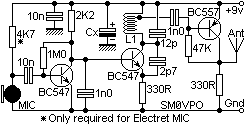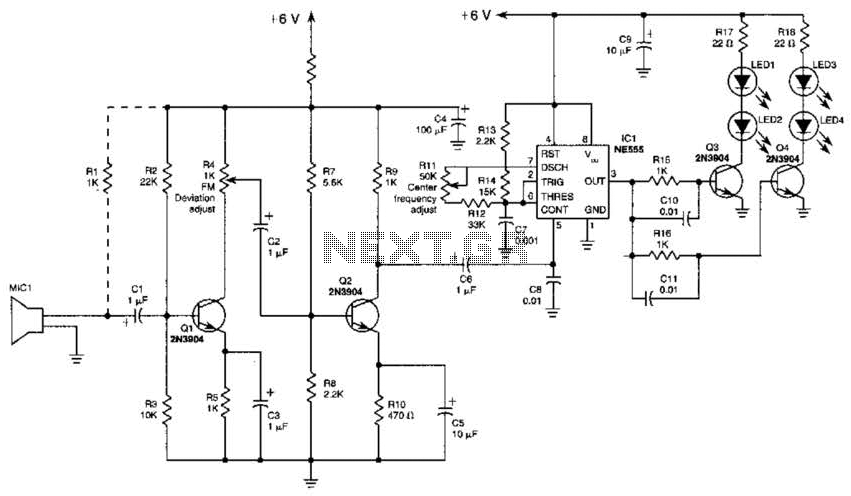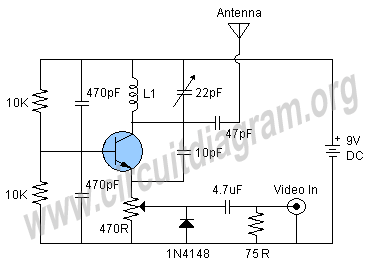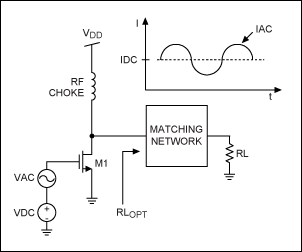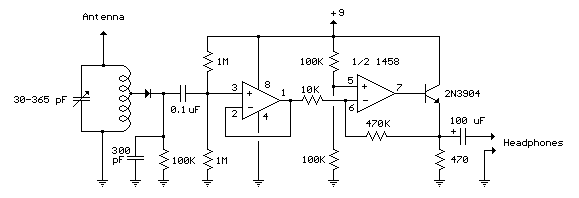
1-Transistor FM Transmitter
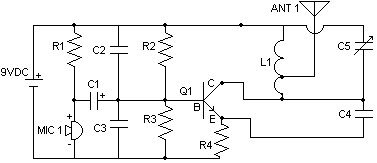
1-Transistor FM Transmitter. R1 27k, R2 56k, R3 12k, R4 100, C1 1u, C2, C3 470p, C4 6 to 10p, C5 1-30p trimmer, L1 etched on PCB.
The 1-transistor FM transmitter is a compact electronic circuit designed to transmit audio signals over a short range using frequency modulation. The circuit primarily consists of passive components such as resistors, capacitors, and an inductor, along with a single transistor that serves as the active amplification element.
The resistors R1, R2, R3, and R4 play crucial roles in setting the biasing conditions for the transistor and controlling the gain of the circuit. Specifically, R1 (27kΩ) and R2 (56kΩ) form a voltage divider that establishes the base bias voltage, ensuring the transistor operates in its active region. R3 (12kΩ) and R4 (100Ω) are used to stabilize the operating point and limit the collector current, respectively.
Capacitors C1 (1μF), C2, and C3 (both 470pF) are used for coupling and bypassing purposes. C1 couples the audio input signal to the base of the transistor, allowing the audio signal to modulate the carrier frequency. C2 and C3 help filter high-frequency noise, ensuring the transmitter operates efficiently and produces a clean output signal.
C4, with a variable capacitance of 6 to 10pF, acts as a tuning capacitor that adjusts the resonant frequency of the circuit along with inductor L1. This tuning capability allows users to select the desired frequency for transmission. C5, a trimmer capacitor with a variable range of 1 to 30pF, is utilized for fine-tuning the output frequency, providing flexibility in achieving optimal performance.
Inductor L1 is typically etched on the PCB, which simplifies the design and minimizes the footprint of the circuit. The inductor, in combination with the capacitors, forms a tank circuit that determines the oscillation frequency of the transmitter.
Overall, this 1-transistor FM transmitter circuit is a simple yet effective design suitable for various applications, including hobbyist projects and educational demonstrations. Its compact size and ease of assembly make it an attractive option for those looking to explore the fundamentals of radio frequency transmission.1-Transistor FM Transmitter. R1 27k R2 56k R3 12k R4 100 C1 1u C2, C3 470p C4 6 to 10p C5 1-30p trimmer L1 etched on PCB or a. 🔗 External reference
The 1-transistor FM transmitter is a compact electronic circuit designed to transmit audio signals over a short range using frequency modulation. The circuit primarily consists of passive components such as resistors, capacitors, and an inductor, along with a single transistor that serves as the active amplification element.
The resistors R1, R2, R3, and R4 play crucial roles in setting the biasing conditions for the transistor and controlling the gain of the circuit. Specifically, R1 (27kΩ) and R2 (56kΩ) form a voltage divider that establishes the base bias voltage, ensuring the transistor operates in its active region. R3 (12kΩ) and R4 (100Ω) are used to stabilize the operating point and limit the collector current, respectively.
Capacitors C1 (1μF), C2, and C3 (both 470pF) are used for coupling and bypassing purposes. C1 couples the audio input signal to the base of the transistor, allowing the audio signal to modulate the carrier frequency. C2 and C3 help filter high-frequency noise, ensuring the transmitter operates efficiently and produces a clean output signal.
C4, with a variable capacitance of 6 to 10pF, acts as a tuning capacitor that adjusts the resonant frequency of the circuit along with inductor L1. This tuning capability allows users to select the desired frequency for transmission. C5, a trimmer capacitor with a variable range of 1 to 30pF, is utilized for fine-tuning the output frequency, providing flexibility in achieving optimal performance.
Inductor L1 is typically etched on the PCB, which simplifies the design and minimizes the footprint of the circuit. The inductor, in combination with the capacitors, forms a tank circuit that determines the oscillation frequency of the transmitter.
Overall, this 1-transistor FM transmitter circuit is a simple yet effective design suitable for various applications, including hobbyist projects and educational demonstrations. Its compact size and ease of assembly make it an attractive option for those looking to explore the fundamentals of radio frequency transmission.1-Transistor FM Transmitter. R1 27k R2 56k R3 12k R4 100 C1 1u C2, C3 470p C4 6 to 10p C5 1-30p trimmer L1 etched on PCB or a. 🔗 External reference
